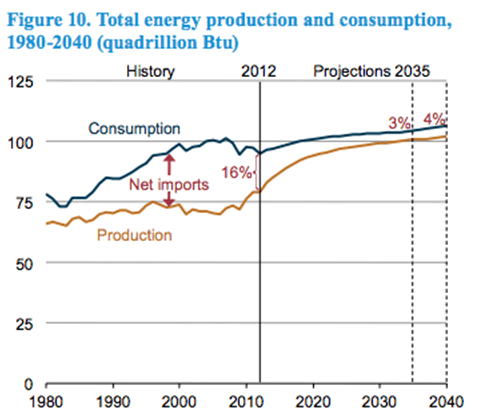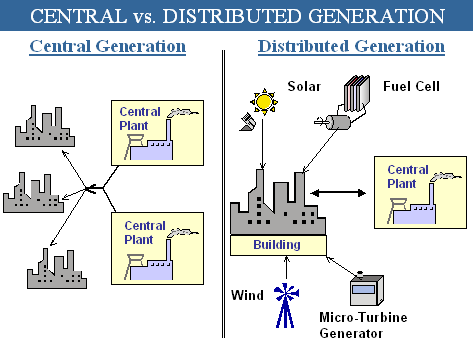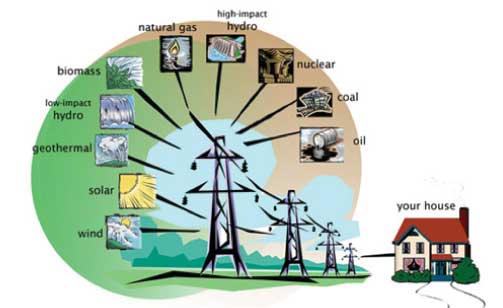Quick Look
Grade Level: 5 (4-6)
Time Required: 1 hours 45 minutes
(50-minutes to introduce concepts; additional class time over a week for task-force meetings and report preparation)
Expendable Cost/Group: US $0.00
Group Size: 28
Activity Dependency: None
Subject Areas: Physical Science, Science and Technology
NGSS Performance Expectations:

| 4-ESS3-1 |

Summary
The class forms a "presidential task force" for a week, empowered by the president to find answers and make recommendations concerning the future of the national power grid. Task force members conduct daily debriefings with the research team and prepare a report and presentation of findings for the president, using a real policy document as a guide. Although this activity is geared towards fifth-grade and older students and Internet research capabilities are required, some portions may be appropriate for younger students.Engineering Connection
An obstacle in using wind energy is getting it connected to the national power grid. Most sites that are good for wind power production are far away from the existing power grid and it costs more to install the transmission lines to connect to the grid than to build the wind turbines. Knowing the location of existing grid lines helps engineers to site new wind farms in areas with affordable accessibility.
Learning Objectives
After this activity, students should be able to:
- Use a full range of strategies to comprehend technical writing.
- Write stories, letters and reports with greater detail and supporting material.
- Choose vocabulary and figures of speech that communicate clearly.
Educational Standards
Each TeachEngineering lesson or activity is correlated to one or more K-12 science,
technology, engineering or math (STEM) educational standards.
All 100,000+ K-12 STEM standards covered in TeachEngineering are collected, maintained and packaged by the Achievement Standards Network (ASN),
a project of D2L (www.achievementstandards.org).
In the ASN, standards are hierarchically structured: first by source; e.g., by state; within source by type; e.g., science or mathematics;
within type by subtype, then by grade, etc.
Each TeachEngineering lesson or activity is correlated to one or more K-12 science, technology, engineering or math (STEM) educational standards.
All 100,000+ K-12 STEM standards covered in TeachEngineering are collected, maintained and packaged by the Achievement Standards Network (ASN), a project of D2L (www.achievementstandards.org).
In the ASN, standards are hierarchically structured: first by source; e.g., by state; within source by type; e.g., science or mathematics; within type by subtype, then by grade, etc.
NGSS: Next Generation Science Standards - Science
| NGSS Performance Expectation | ||
|---|---|---|
|
4-ESS3-1. Obtain and combine information to describe that energy and fuels are derived from natural resources and their uses affect the environment. (Grade 4) Do you agree with this alignment? |
||
| Click to view other curriculum aligned to this Performance Expectation | ||
| This activity focuses on the following Three Dimensional Learning aspects of NGSS: | ||
| Science & Engineering Practices | Disciplinary Core Ideas | Crosscutting Concepts |
| Obtain and combine information from books and other reliable media to explain phenomena. Alignment agreement: | Energy and fuels that humans use are derived from natural sources, and their use affects the environment in multiple ways. Some resources are renewable over time, and others are not. Alignment agreement: | Cause and effect relationships are routinely identified and used to explain change. Alignment agreement: Knowledge of relevant scientific concepts and research findings is important in engineering.Alignment agreement: Over time, people's needs and wants change, as do their demands for new and improved technologies.Alignment agreement: |
International Technology and Engineering Educators Association - Technology
-
The use of technology affects the environment in good and bad ways.
(Grades
3 -
5)
More Details
Do you agree with this alignment?
-
Tools, machines, products, and systems use energy in order to do work.
(Grades
3 -
5)
More Details
Do you agree with this alignment?
State Standards
Colorado - Science
-
Identify and describe the variety of energy sources
(Grade
4)
More Details
Do you agree with this alignment?
-
Use multiple resources – including print, electronic, and human – to locate information about different sources of renewable and nonrenewable energy
(Grade
4)
More Details
Do you agree with this alignment?
Materials List
- Paper and pencils
- Access to the Internet
- U.S. Energy Information Administration Total Energy Overview (online)
- Annual Energy Outlook 2014
- U.S. National Energy Policy: Reliable Affordable and Environmentally Sound Energy for America's Future (also online)
- Overview of U.S. National Energy Policy (also online)
Worksheets and Attachments
Visit [www.teachengineering.org/activities/view/cub_energy2_lesson04_activity5] to print or download.Pre-Req Knowledge
A basic understanding of electrical energy (charge, voltage, current, resistance), and its pervasiveness in our way of life (lights, heat, safety, appliances, computers, medical equipment, transportation, entertainment).
Introduction/Motivation
Have you ever thought about how much your life depends on electricity? What would it be like to live without electricity? What would it be like if blackouts and brownouts happened every week or even every day? That's how people already live in some locations where the electrical power delivery system is unreliable and cannot keep up with demand. Could that happen in the U.S.? It could if the warning of the 2014 report (https://www.eia.gov/forecasts/aeo/er/pdf/0383er(2014).pdf), is not taken seriously.

U.S. energy consumption is outpacing production, which is from the overview of that energy policy report. The space between the blue line, representing energy consumption, and the orange line, representing the energy production rate from 1980-2040, indicates the "energy shortfall." We already do not produce enough energy to meet demand, and need to make changes to the way we use energy in years to come to avoid a problem. The energy crisis in California in recent years and the general increase in electrical rates are a strong indication of existing problems and a sign of worse to come. When supply falls short of demand, brownouts occur, which are temporary reductions in electrical power (voltage) for short periods until demand gets back in line with supply. If the demand is so great it puts a strain on the system, the system is disrupted and blackouts occur.

What is the best way to increase the supply of power to the level of demand? Should we build more central power plants? Should we develop alternative sources of power and a more decentralized (distributed) system of energy delivery? Or, should we do both? Or, is there any way to reduce the growing demand? These are questions to explore in this activity. You will form a Presidential Task Force to find answers and make recommendations concerning the future of the national power grid. In this activity, you will not be considering the related issue of developing sources of fuel used to generate the electricity. Your focus is on the electrical power distribution system, the power grid itself. Explore the topics of distributed energy (see Figure 2) and alternative energy (see Figure 3) before completing your task force recommendations.

Task force members have daily debriefings with their research team over the course of a week and prepare a report and presentation of their findings for the president. Use the policy document, U.S. National Energy Policy: Reliable, Affordable and Environmentally Sound Energy for America's Future, as a guide.
Procedure
Divide the class equally between Task Force (TF) members, researchers and presidential staff roles, including the president. The researchers do the background work and present their findings to the TF. The job of the TF is to prepare and present the recommendations. The presidential staff hears the presentation and challenges the findings of the TF. The class as a whole prepares the final summary of recommendations.
Observing
First, let's do some background reading and research. Start with the basics: How does the power grid actually work? Research on the Internet at the following two sources that provide clear explanations of the fundamentals: U.S. Department of Energy's page on Electricity Grid: How the Grid Works, https://www.energy.gov/articles/infographic-understanding-grid, and How Power Grids Work, http://www.howstuffworks.com/power.htm.
Next, find out how the power grid does not work. While the links provided under the References section include some helpful information, the following two sources are especially useful on the problems associated with the power grid and what needs to be done: "What's wrong with the electric grid?" https://physicstoday.scitation.org/do/10.1063/PT.5.5020/full/ , and Building the Power Grid of the Future, https://news.gatech.edu/features/building-power-grid-future.
Become familiar with the presidential policy statement, Blueprint for a Secure Energy Future, https://obamawhitehouse.archives.gov/issues/blueprint-secure-energy-future. For a summary, google Overview of U.S. National Energy Policy to get background knowledge on national energy policy.
Thinking
Twenty years from now, will the entire world be sharing electricity through one grid?
"Some 30 years ago, Buckminster Fuller came up with a plan to plug all the world's continents into the same electrical grid. The idea was to let power flow between, say, Siberia and the northwestern US, or Norway and Laos. Energy companies dismissed the notion as pie in the sky — and then proceeded to build such a grid. To get the most use of their generation capacity and to maintain an emergency reserve, power companies found it efficient to connect their grids to their neighbor's, who then connected to their neighbor's.
"The result, according to Peter Meisen of the Global Energy Network Institute, is that the electricity grids of all the nations of North and South America should be interconnected within the next 10 years.
"...Once the [international] grid is fully functional, the only excuse for power shortages will be greed. When demand is high in one region, it's almost certain to be low in another. By making electric power as easily transferrable as data, analysts expect a global grid to smooth the market spikes out of the world's most useful commodity."
Source: Power Up!, http://www.wired.com/wired/archive/11.09/start.html?pg=17
What do you think? How will the development of the international power grid affect your recommendations concerning the U.S. power grid? What will be the advantages and disadvantages of such a system? Should we be concerned that, "...the only excuse for power shortages will be greed"?
Writing
The written report for this activity can be as simple as a list of recommendations with a rationale (reasons) for each recommendation. Or, the class can write a more formal report, using the Overview of National Energy Policy, U.S. National Energy Policy: Reliable, Affordable and Environmentally Sound Energy for America's Future documents as models.
Vocabulary/Definitions
blackout: Lack of illumination caused by an electrical power failure; the failure of electric power for a general region.
brownout: A reduction or cutback in electric power, especially as a result of a shortage, a mechanical failure, or overuse by consumers.
commodity: A resource (such as electricity) that can be turned to commercial or other advantage.
connotation: An idea or meaning suggested by or associated with a word or thing; the set of associations implied by a word in addition to its literal meaning.
debriefing: Report of a mission or task.
denotation: The most specific or direct meaning of a word, in contrast to its figurative or associated meanings.
electrical distribution and transmission system: The power grid.
generate: To produce.
infrastructure: The basic facilities, services, and installations needed for the functioning of a community or society, such as transportation and communications systems, water and power lines, and public institutions including schools, post offices, and prisons.
literal and figurative language: Literal: Limited to the simplest, nonfigurative, or most obvious meaning of a word or words. Figurative: Based on or making use of figures of speech; metaphorical.
power grid: A network of electric power lines and associated equipment used to transmit and distribute electricity over a geographic area. The network of transmission lines that link all generating plants in a region with local distribution networks to help maximize service reliability.
power plant: A complex of structures, machinery and associated equipment for generating electric energy from another source of energy, such as nuclear reactions or a hydroelectric dam. Also called a powerhouse or power station.
power substation: A subsidiary station at which electricity is transformed for distribution by a low-voltage network.
task force: A legislative committee authorized by legislative leadership to study a specific subject for a specified period of time. A task force may contain lay members (regular citizens) and is different from a committee in that it typically considers a narrow subject within a broader topic area. Source: www.leg.state.or.us/glossary.html
transformer: A device used to transfer electric energy from one circuit to another, especially a pair of multiply wound, inductively coupled wire coils that effect such a transfer with a change in voltage, current, phase or other electric characteristic.
Assessment
Pre-Activity Assessment
Call-Out Questions and Quiz: Use call-out questions and a vocabulary quiz to reinforce basic concepts and vocabulary as they are introduced during the Observing activity.
Activity Embedded Assessment
Call-Out Questions: During the Thinking discussion, use call-out questions to test students' understanding of the concepts.
Post-Activity Assessment
Presentations/Writing: The students' presentations of research findings and written report demonstrate their understanding of the concepts.
Safety Issues
In this activity, students become aware of the infrastructure of the national power grid, which links their own homes to the central power station. Students should be strongly warned to be cautious if they become curious about any of the associated equipment and to stay away from it. Such warnings could effectively be given on the Power Hike suggested under the Activity Extensions section.
Activity Extensions
Power Hike: Take a class hike or field trip to identify elements of the transmission system, such as: high voltage transmission lines, transmission substation, power pole (three-wire), regulator bank, taps, transformer drum, fuses and circuit breakers, and outlet. Remember to stay at a safe distance from high voltage power lines and other dangerous equipment.
Figuratively Speaking: A "grid" is a "framework of crisscrossed or parallel bars; a grating or mesh." When the term is used to describe the electrical power grid, it is being used as a metaphor. Metaphors have certain psychological and emotional associations or connotations. What does the "grid" metaphor suggest to you about the power grid? How does it affect how people think about it? What are some of the positive connotations of the word? What are some negative connotations? (Possible answers: Being connected in a grid can be both positive and negative in the sense that the system is efficient in some respects and inefficient in others. It is efficient because it allows for load-sharing and independent distributors can sell energy to the system. The system is inefficient when brownouts and blackouts occur because the very interconnectedness of the grid makes it vulnerable to terrorism. People can feel as though they are too dependent on the grid, even to the extent that they are at its mercy, a strong negative in the minds of some. The mesh suggested in the metaphor of the grid can feel like a wire cage. Electric towers can look like ominous metal giants striding across the landscape; see the introductory image.)
Activity Scaling
As suggested under the Writing section, the written report can range from a simple list of recommendations or a full written report.
Subscribe
Get the inside scoop on all things TeachEngineering such as new site features, curriculum updates, video releases, and more by signing up for our newsletter!More Curriculum Like This

Students learn and discuss the advantages and disadvantages of renewable and non-renewable energy sources. They also learn about our nation's electric power grid and what it means for a residential home to be "off the grid."

Students research the feasibility of installing a wind-turbine distributed energy (DE) system for their school. They write a proposal (actually, an executive summary of a proposal) to the school principal based on their findings and recommendations.

Students learn how the sun can be used for energy. They learn about passive solar heating, lighting and cooking, and active solar engineering technologies (such as photovoltaic arrays and concentrating mirrors) that generate electricity.
References
Brain, Marshall. How Power Grids Work. How Stuff Works. Accessed October 3, 2005. http://www.howstuffworks.com/power.htm
Chapter 3: The U.S. Electric Power Industry Infrastructure: Functions and Components. Updated October 3, 2005. The Changing Structure of the Electric Power Industry 2000: An Update, Energy Information Administration, U.S. Department of Energy. Accessed October 3, 2005. http://www.eia.gov/cneaf/electricity/chg_stru_update/chapter3.html
Cheyne, Hilary and Mor, David. The Power Infrastructure, CS99 PreY2K Report. Updated March 14, 1999. Computer Science 99, Dartmouth College Computer Science. Accessed October 3, 2005. http://www.cs.dartmouth.edu/Y2K/power-CM/
Dictionary.com. Lexico Publishing Group, LLC. Accessed October 3, 2005. (Source of vocabulary definitions, with some adaptation.)
Electricity Grid: How the Grid Works, Distributed Energy Program. Updated April 4, 2005. Energy Efficiency and Energy Renewal, U.S. Department of Energy. Accessed October 3, 2005. http://www.eere.energy.gov/de/electricity_grid.html
Lerner, Eric J. "What's wrong with the electric grid?" The Industrial Physicist, American Institute of Physics, Vol. 9, Issue 5, p. 8. Accessed October 3, 2005. (highly recommended) http://www.aip.org/tip/INPHFA/vol-9/iss-5/p8.html
National Energy Policy Overview. The White House. Accessed October 3, 2005. www.whitehouse.gov/energy/
"Reliable, Affordable and Environmentally Sound Energy for America's Future." National Energy Policy. The White House. Accessed October 3, 2005. www.whitehouse.gov/energy/
Power Grid of the Future. Oak Ridge National Laboratory, U.S. Department of Energy. Accessed October 3, 2005. http://www.ornl.gov/info/ornlreview/v35_2_02/power_grid.shtml
Power Up! Published September 2003. Wired Magazine, Lycos, Inc and Condé Nast Publications Inc. Accessed October 3, 2005. (For the teacher. Includes a graphic of the proposed international grid.) http://www.wired.com/wired/archive/11.09/start.html?pg=17
Copyright
© 2005 by Regents of the University of ColoradoContributors
Jane Evenson; Malinda Schaefer Zarske; Denise W. CarlsonSupporting Program
Integrated Teaching and Learning Program, College of Engineering, University of Colorado BoulderAcknowledgements
The contents of this digital library curriculum were developed under grants from the Fund for the Improvement of Postsecondary Education (FIPSE), U.S. Department of Education and National Science Foundation (GK-12 grant no. 0338326). However, these contents do not necessarily represent the policies of the Department of Education or National Science Foundation, and you should not assume endorsement by the federal government.
Last modified: August 16, 2020








User Comments & Tips